| CPSC 120 |
Principles of Computer Science |
Fall 2025 |
Lab 8
Repetition, Again
Due: Fri 11/7 at the start of class
Introduction
Loops provide a powerful shortcut for repetition — instead of cutting
and pasting (with lots of small, tedious, error-prone edits) to get
multiple copies of something, a loop allows you to repeat things as
often as you want with only a few extra lines of code.
This week's lab focuses on breaking up complex pictures into loops,
and working with the different loop patterns discussed in class
(repeat-as-long-as loops and counting loops; one thing in the loop
body, multiple things in the loop body; a single loop variable,
multiple loop variables; a single loop, one loop after another, nested
loops). Quilts once again provide a source of inspiration.
Successfully completing this lab means that you are able to:
-
recognize applications of the loop patterns identified above
-
decompose a complex pattern into loops
-
construct sketches using loops, including
- identifying when loop(s) are needed
- identifying when the repeat-as-long-as and counting loop
patterns are applicable
- identifying when a pattern calls for a single loop, one
loop after another, and nested loops
- using the loop questions and the patterns to successfully
construct loop(s) to accomplish a task
-
work with loops in Processing, including
- writing syntactically correct loops, for both single loops and nested loops
- describing the sematics of the loop statement (what it does)
- using the relational operators ==, !=, <,
>, <=, and >=
- using the logical operators &&, ||, !
- writing and understanding boolean expressions
Handin and Presentation Meeting
Handin
Hand in a hardcopy (paper) of your worksheet in class.
To hand in your sketches:
-
Make sure that your name and a short description of the
sketch are included in a comment at the beginning of each
sketch.
-
Make sure that you've auto-formatted each sketch.
-
Copy the entire lab8a, lab8b, lab8c,
and lab8d
directories from your sketchbook (~/cs120/sketchbook) to
your handin directory (found
inside /classes/cs120/handin).
It is OK if you copy your files to the handin directory at the very
beginning of class.
Presentation Meeting
Presentation meetings for this lab will be the week of Nov
3.
Exercise #4 is the presentation problem. Come
to the presentation meeting prepared to discuss your sketch. You may
be asked to point out and explain how your code meets the requirements
of the problem, explain how portions of your code work, and/or apply
skills from the problem to a new situation.
Policies
The policies on late work and extensions, academic
integrity, and the use of AI for this lab are the same as
for lab 2. Review them there.
Preliminaries
- This section contains important information needed for the
assignment. Read through it before starting on the exercises so
you know what it contains information about, then come back for a
closer look at the details when they are relevant to your task.
Decomposition Into Loops
There are three main patterns of repeated elements:
-
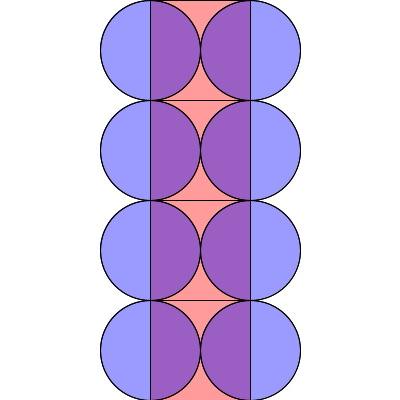
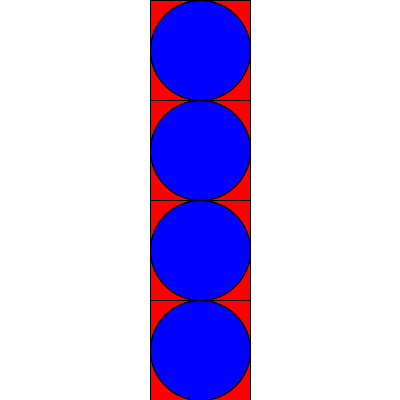
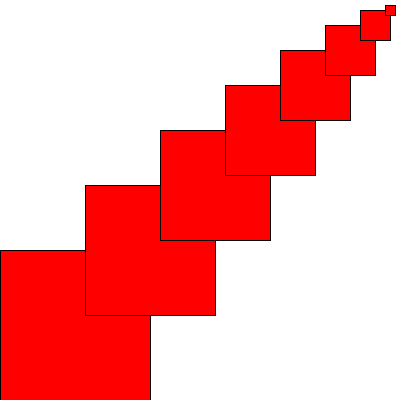
A single loop, with one or more loop variables, applies
when the answers to "what is repeated?", "what changes?", and "how
do things change?" are the same for all repetitions.
-
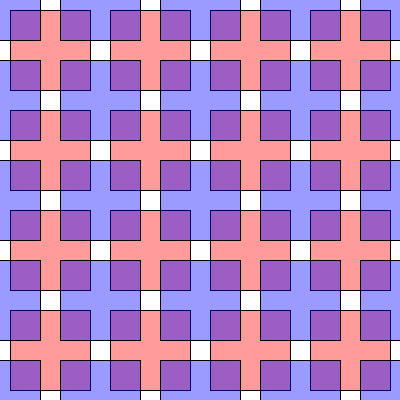
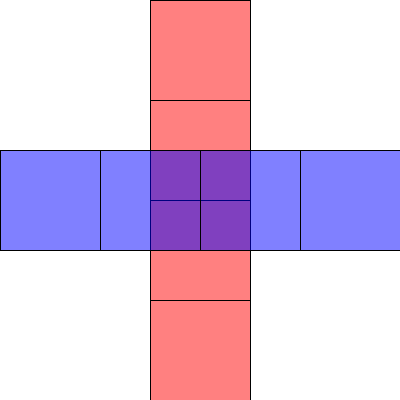
Multiple loops one after another applies when elements
can be grouped into two or more groups where the answers for the
loop questions ("what is repeated?", "what changes?", "how do
things change?", "how do things start?", and/or "when do you keep
going?" are the same for all repetitions within one group but
different for different groups.
Note: the rightmost example includes both multiple loops and
nested loops — the red squares and the blue squares are
drawn with separate loops, one after another, with nested loops
being used to draw each grid of squares.
-

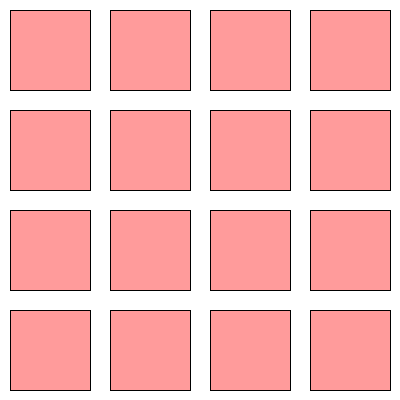
Nested loops applies when the answer to "what
changes?" and/or "how do things change?" involves "sometimes"
— elements can be grouped so that "what changes?" and "how
do things change?" is the same for the elements within each group
and also between groups (though with different answers between
groups than within groups).
With a grid, a common application of nested loops, elements can be
grouped into rows and/or columns which are then repeated.
Note: the rightmost example includes both multiple loops and
nested loops — the red squares and the blue squares are
drawn with separate loops, one after another, with nested loops
being used to draw each grid of squares.
Reference
Review the slides, in-class exercises handouts, and in-class
exercise solutions from the last several weeks — and especially
the identifying loops and nested loops materials from Monday —
for information, templates, and examples.
Exercises
-
Do the exercises in order.
-
Read through all of each exercise before you start on it. In
particular, note that the "to do this" steps are what you should
actually do to complete the exercise — don't just read the
first sentence of the problem, look at the example, and try to
write the sketch from there. Follow the steps!
-
Use loops whenever it is appropriate to do so! You will
receive very little credit for producing the right drawing
without loops.
-
Put your name and a description of the sketch in comments at the
beginning of each sketch. Also don't forget to Auto Format your code
before handing it in.
-
Be sure to save your sketch frequently (ctrl-S). (Every
time you run your sketch is good.) The editor does not
auto-save!
-
In this exercise you'll create a sketch which draws a strip of 16
flying geese as shown below. Recall from lab 7 that each "goose" is a triangle
whose long dimension is twice the length of the short dimension; for
a horizontally-oriented pattern like the one shown, this means the
height of the triangle is twice the width.

The requirements for your sketch:
-
Name the sketch lab8a.
-
The drawing window should be sized to exactly fit 16
triangles that are as tall as the window and half as wide as
they are tall.
-
You can choose your own colors, but each group of four
triangles should be the same color and the color of successive groups
should change smoothly, as shown. (In the example, the red component
of the color increases to the right.)
To do this:
-
Complete the Exercise 1 section of
the lab 8 worksheet.
-
Create a new sketch, add your name and a
description of the sketch in comments at the beginning, and
save it as lab8a.
-
Start with the basic sketch structure: open a drawing window
and clear the background.
-
Write the loop(s) to draw the entire pattern.
-
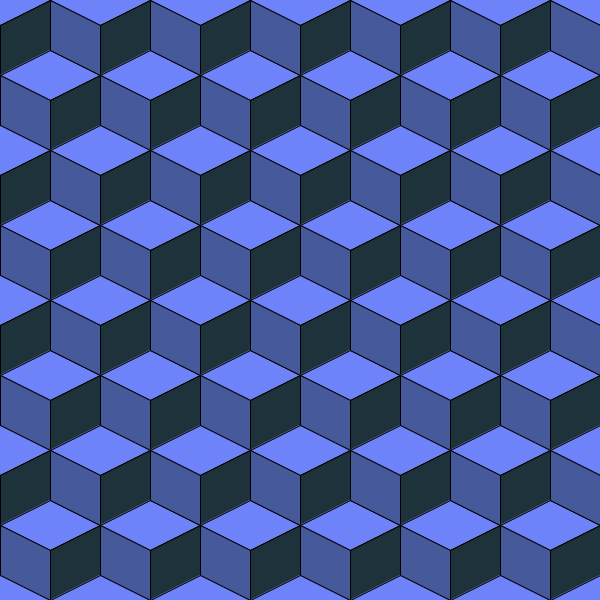
In this exercise you'll create a sketch which
draws a tumbling blocks quilt, as shown.
The requirements for your sketch:
-
Name the sketch lab8b.
-
The drawing window should be square.
-
Design your sketch so it works with any size window.
-
The window should be completely filled; you do not need to
match the example exactly in terms of the number of repetitions
of the pattern. It is OK to draw some elements outside the
window to avoid gaps, but you should not draw any blocks
entirely outside the window.
-
You can choose your own colors, but should use lighter,
medium, and darker colors in the configuration shown.
To do this:
-
Create a new sketch, add your name and a
description of the sketch in comments at the beginning, and
save it as lab8b.
-
Complete the Exercise 2a section of
the lab 8 worksheet.
-
Write the function definition for drawBlock,
then call it from draw() to test it. Remove the
call once the function is working.
-
Complete the Exercise 2b section of
the lab 8 worksheet.
-
Write the loop(s) identified on the worksheet to draw
the entire pattern.
-
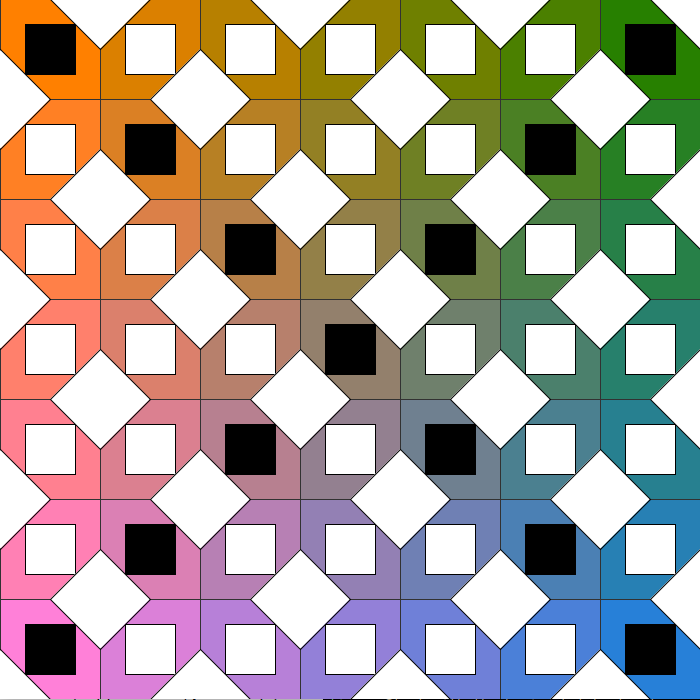
In this exercise you'll create a sketch which displays a variation
of a block star quilt, as shown. (To see the star pattern, focus on
the regions with color rather than the black and white shapes.)
The requirements for your sketch:
-
Name the sketch lab8c.
-
The drawing window should be square.
-
Design your sketch so it works with any size window.
-
You can choose your own colors, but you should vary one
color component horizontally and a different one vertically. (In
the example, the red decreases to the right and the blue increases
going down.) The black and white elements should be black and white
as shown.
To do this:
-
Create a new sketch, add your name and a
description of the sketch in comments at the beginning, and
save it as lab8c.
-
Start with the basic sketch structure: open a drawing window
and clear the background.
-
Complete the Exercise 3a section of
the lab 8 worksheet.
-
Draw the background pattern.
-
Complete the Exercise 3b section of
the lab 8 worksheet.
-
Draw the white squares.
-
Complete the Exercise 3c section of
the lab 8 worksheet.
-
Draw the black squares.
-
Complete the Exercise 3d section of
the lab 8 worksheet.
-
Draw the white quads.
-
In this exercise you'll create a sketch of your own
design. What the sketch depicts is up to you (here's a chance to be
creative!) but for full credit it must include the following
elements:
-
Name the sketch lab8d.
-
The scene must be recognizable as something and/or there must
be a deliberately-created geometric pattern. Include a comment at
the beginning of the sketch describing what it depicts. The
intent is that you should deliberately choose positions and colors
for the shapes — simply drawing a bunch of shapes at
whatever location they happen to end up at is not acceptable.
Simplifying things (like making a tree out of a rectangle and a
triangle) is fine. It is OK to have multiple scenes and/or
geometric patterns — treat each thing like a quilt block and
arrange the blocks into a whole quilt.
-
The scene must be original and created by you — it can
be something entirely new for this exercise or you can extend your
sketches for #4 in previous labs. You may not, however,
copy code from other exercises in this lab, examples or solutions
in the textbook or from class, or other sources even if you then
make some changes — create your own version (such as a
fancier car) from scratch.
-
Demonstrate different loop patterns. In particular, there
must be at least one instance of each of the following:
- only one property varies from one repetition to the next
- more than one property (excluding counters) varies from one
repetition to the next
- a counting loop
- a repeat-as-long-as loop
- two or more loops one after another (not nested) are needed to
create a single pattern
- nested loops (or a loop which calls a drawing function containing
a loop)
Note that you don't necessarily need exactly six
loops — one loop can satisfy or go towards satisfying more than
one of these criteria at a time, and several criteria require more
than one loop to be complete. Include a comment with each loop
identifying the pattern.
-
Combine animation with loops. Include the following:
- an instance where the animation variable(s) and loop variable(s)
are different properties (such as the stack of circles-and-squares
moving side-to-side)
- an instance where at least one of the animation variables
involves the same property as the loop variable(s) (such as the stack
of circles-and-squares moving up and down)
The two examples mentioned are from Monday's "identifying loops"
slides
To do this:
-
Create a new sketch, add your name and a
description of the sketch in comments at the beginning, and
save it as lab8d.
-
For each pattern involving repetition, complete one page
of the Exercise 4 section of
the lab 8 worksheet before
writing the code for the loop(s).
Extra Credit
Challenge yourself and earn extra credit by going substantially beyond
the required elements.
(See
the assignments and evaluation
policy for more details on extra credit.)
For extra credit, add elements to your lab8d sketch. Some
possibilities include:
-
More — a more elaborate sketch, with additional
(appropriately used) loops. (It's the loops that earn extra
credit, not the "more" part on its own.)
-
Demonstrate more complex ways in which things change from one repetition
to the next. This could include changing things other than position,
size, or color (such as orientation — use rotate()) or
accelerating/decelerating the change. The "twisted square and
variations" and "circular patterns" examples from the extra credit
section in lab 8 have some examples of quilt blocks where orientation
varies. Another possibility is repetition in space that isn't in a
straight line, such as creating a Ferris wheel or water wheel by
positioning things around a circle.
-
Additional instances of combining loops with animation and/or
interaction. A spinning
Ferris wheel or water wheel is one such possibility.









